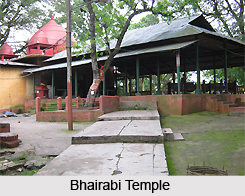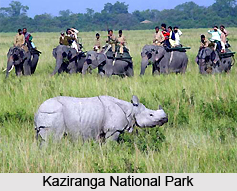 Tourism in Tezpur has been a major venture for he state government of Assam. The state has taken full care to develop some prominent sights in Tezpur which can turn to more attractive for the tourist in background of rich green environment. Tezpur has some local sites of interests which include the prominent places like Agnigarh hills, Agnigarh which is also known for Usha-Aniruddha Udyan, Bhairabi Temple that is dedicated to goddess Durga also known as Maithan or Bhairabi Devalaya, Cole Park - also known as Chitralekha Udyan, Kolia Bhomora Setu - a 3.015 km long road bridge across the Brahmaputra, Ketakeshwar Dewal - Shiva shrine, Mahabhairav Temple - Shiva shrine, Padum Pukhuri - Central lake with an island in the middle, Rudrapath - Shiva shrine,Bamuni Pahar, Da Parbatia Gate of Gupta period,Hazara pukhuri- Pond of gupta period, and Nag Shankar- Temple of Lord Shiva. Within its prominent places tezpur has some of the most revered shiva temples which carry the religious legend of the state.
Tourism in Tezpur has been a major venture for he state government of Assam. The state has taken full care to develop some prominent sights in Tezpur which can turn to more attractive for the tourist in background of rich green environment. Tezpur has some local sites of interests which include the prominent places like Agnigarh hills, Agnigarh which is also known for Usha-Aniruddha Udyan, Bhairabi Temple that is dedicated to goddess Durga also known as Maithan or Bhairabi Devalaya, Cole Park - also known as Chitralekha Udyan, Kolia Bhomora Setu - a 3.015 km long road bridge across the Brahmaputra, Ketakeshwar Dewal - Shiva shrine, Mahabhairav Temple - Shiva shrine, Padum Pukhuri - Central lake with an island in the middle, Rudrapath - Shiva shrine,Bamuni Pahar, Da Parbatia Gate of Gupta period,Hazara pukhuri- Pond of gupta period, and Nag Shankar- Temple of Lord Shiva. Within its prominent places tezpur has some of the most revered shiva temples which carry the religious legend of the state.
Tezpur is one of the most picturesque cities of Assam which is located at the north bank of River Brahmaputra. This is considered as the gateway of Arunachal Pradesh which forms the backdrop of this small hilly city. This has some undulating green valleys and evergreen tea gardens which add to the panoramic view of the city. Surrounded with popular tourist spot the place is often known for some of the legends which claim that once there had been a fierce battle between Lord Shiva and Lord Krishna. This sank the state into blood after which the place was named as Tezpur which also known as sonitpur is meaning city of Blood. This has some of the most prominent places to visit which not only describe the legend of the city but also the scenic beauty which surrounds these places.
 Among the major sights Agnigarh is a fortress which was built by Banasura to keep his daughter Usha in isolation. As princess Usha fell in love with Annirudh, this fotress was built which was surrounded by fire. Princess Usha fell in love with Annirudh in her dreams without seeing him. He was identified by her friend. Presently the fort is located at the bank of river Brahmaputra which adds to the scenic beauty of the fort.
Among the major sights Agnigarh is a fortress which was built by Banasura to keep his daughter Usha in isolation. As princess Usha fell in love with Annirudh, this fotress was built which was surrounded by fire. Princess Usha fell in love with Annirudh in her dreams without seeing him. He was identified by her friend. Presently the fort is located at the bank of river Brahmaputra which adds to the scenic beauty of the fort.
Along with some most picturesque tourist spot the palace has some of the ancient religious shrines. One of them is Bhairabi Temple dedicated to Goddess Durga which is located at the outskirts of Tezpur. The place has some of the popular shrines of lord Shiva which are known as Ketakeshwar Dewal and Mahabhairav Temple which are known for its legends. These are some of the age old shrines of Tezpur. Alongwith these Tezpur has a number of lakes and parks like Cole Park and Padam Phukuri central lake which attract the tourist from distant areas.
Tourism in Tezpur also includes some of the most prominent places. Among this Tawang which is age old monastry is located at a distance of 12 hrs drive from Tezpur. Bomdila which is the district headquarters of West Kameng is also located at aq small distance which can be easily reached with a drive of 5 hrs. This is mainly known for its apple orchids trekking trails and forests which excite the tourists of Tezpur. Pakki and eagle nest are some of the most attractive tiger sanctuary and birds point located in Tezpur. Alongwith the place has some historical sights like Hazara Phukuri a pond of Gupta period and Da Parbatia which is considered the gateway of Gupta period.
Thus surrounded with various types of tourist spot Tezpur has been well visited by the tourists from all over the world. With its greenery this place encourages some of the eco camps and trekking. Tezpur is also closely located near the national parks like Kaziranga National Park which is at a distance of 40 kms from Tezpur, Orange national park at a distance of 320 kms and Nameri national park which is at 35 kms and can be reached easily. As such with its pleasant atmosphere it often lure the tourists to visist all these areas without any restriction.



















